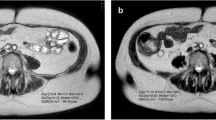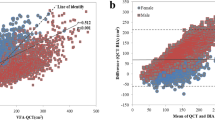Abstract
Background/Objectives:
Abdominal obesity, more specifically increased intra-abdominal adipose tissue, is strongly associated with increased risk of metabolic disease. Bioelectrical impedance analysis (BIA) has been proposed as a potential method of determining individual abdominal fat compartments in the form of the commercially available ViScan measurement system (Tanita Corporation), but it has yet to be independently validated. The objective of this study was to analyse the validity of the ViScan to assess adult abdominal adiposity across a range of body fatness.
Subjects/Methods:
This was a cross-sectional study with 74 participants (40 females and 34 males with body mass index (BMI) between 18.5 and 39.6 kg/m2). Total abdominal adipose tissue, subcutaneous abdominal adipose tissue (SAAT) and intra-abdominal adipose tissue (IAAT) were measured by magnetic resonance imaging (MRI). In addition, intra-hepatocellular lipid was obtained by magnetic resonance spectroscopy. Estimates of abdominal adiposity (total and compartmental) were obtained from BIA and anthropometry.
Results:
ViScan-derived percentage trunk fat strongly and significantly related with total abdominal adipose tissue and SAAT in both lean and overweight/obese individuals, and categorized individuals reliably in terms of total abdominal fat. ViScan-derived ‘visceral’ fat correlated significantly with IAAT but the strength of this relationship was much weaker in overweight/obese individuals, particularly those with higher SAAT, leading to less reliable classification of individuals for IAAT.
Conclusions:
The ViScan may serve as a useful tool for predicting total abdominal fat, but prediction of visceral fat (IAAT) may be limited, especially in abdominally obese individuals.
This is a preview of subscription content, access via your institution
Access options
Subscribe to this journal
Receive 12 print issues and online access
$259.00 per year
only $21.58 per issue
Buy this article
- Purchase on Springer Link
- Instant access to full article PDF
Prices may be subject to local taxes which are calculated during checkout




Similar content being viewed by others
References
Baker LE (1989). Principles of the impedance technique. IEEE Eng Med Biol Mag 8, 11–15.
Baumgartner RN (1996). Electrical impedance and total body electrical conductivity. In: Roche AF, Heymsfield SB, Lohman TG (eds). Human Body Composition. Human Kinetics: Champaign, IL. pp 79–107.
Baumgartner RN, Chumlea WC, Roche AF (1989). Estimation of body composition from bioelectrical impedance of body segments. Am J Clin Nutr 50, 221–226.
Baumgartner RN, Ross R, Heymsfield SB (1998). Does adipose tissue influence bioelectrix impedance in men and women? J Appl Physiol 84, 257–262.
Bland JM, Altman DG (1986). Statistical methods for assessing agreement between two methods of clinical measurement. Lancet 1, 307–310.
Bracco D, Thiebaud D, Chiolero RL, Landry M, Burckhardt P, Schutz Y (1996). Segmental body composition assessed by bioelectrical impedance analysis and DXA in humans. J Appl Physiol 81, 2580–2587.
Chumlea WM, Guo SS (2000). Assessment and prevalence of obesity: application of new methods to a major problem. Endocrine 13, 135–142.
Clasey JL, Bouchard C, Teates CD, Riblett JE, Thorner MO, Hartman ML et al. (1999). The use of anthropometric and dual-energy X-ray absorptiometry (DXA) measures to estimate total abdominal and abdominal visceral fat in men and women. Obes Res 7, 256–264.
Demerath EW, Sun SS, Rogers N, Lee M, Reed D, Choh AC et al. (2007). Anatomical patterning of visceral adipose tissue: race, sex and age variation. Obesity 15, 2984–2993.
Demura S, Sato S (2007). Prediction of visceral fat area at the umbilicus level using fat mass of the trunk: the validity of bioelectrical impedance analysis. J Sports Sci 25, 823–833.
Després JP, Lemieux I (2006). Abdominal obesity and metabolic syndrome. Nature 444, 881–887.
Fox CS, Massaro JM, Hoffmann U, Pou KM, Maurovich-Horvat P, Liu CY et al. (2007). Abdominal visceral and subcutaneous adipose tissue compartments: association with metabolic risk factors in the Framingham Heart Study. Circulation 116, 39–48.
Fuller NJ, Fewtrell MS, Dewit O, Elia M, Wells JCK (2002). Segmental bioelectrical impedance analysis in children aged 8-12y: 2. The assessment of regional body composition and muscle mass. In J Obes 26, 692–700.
Gabriel C, Gabriel S, Corthout E (1996). The dielectric properties of biological tissues: 1. Literature survey. Phys Med Biol 41, 2231–2249.
Geddes LA, Baker LE (1967). The specific resistance of biological material—a compendium of data for the biomedical engineer and physiologist. Med Biol Eng 5, 271–293.
Gielen FL, Wallinga-de Jonge W, Boon KL (1984). Electrical conductivity of skeletal muscle tissue: experimental results from different muscles in vivo. Med Biol Eng Comput 22, 569–577.
Kay SJ, Fiatarone Singh MA (2006). The influence of physical activity on abdominal fat: a systematic review of the literature. Obes Rev 7, 183–200.
Kuk JL, Katzmarzyk PT, Nichaman MZ, Church TS, Blair SN, Ross R (2006). Visceral fat is an independent predictor of all-cause mortality in men. Obesity 14, 336–341.
Kuk JL, Lee SJ, Heymsfield SB, Ross R (2005). Waist circumference and abdominal adipose tissue distribution: influence of age and sex. Am J Clin Nutr 81, 1330–1334.
Kyle UG, Boseaus I, De Lorenzo AD, Deurenberg P, Elia M, G JM et al. (2004). Bioelectrical impedance analysis—part I: review of principles and methods. Clin Nutr 23, 1226–1243.
Lee SY, Gallagher D (2008). Assessment methods in human body composition. Curr Opin Clin Nutr Metab Care 11, 566–572.
Minaguchi M, Kasahara Y, Sakai Y, Sato H, Hosoya T (2007). Body fat measurements using abdominal BIA in male patients with spinal cord injury. 42nd Annual Meeting Medical Society of Spinal Cord Lesions (9-10 November) 2007.
Misra A, Vikram NK (2003). Clinical and pathophysiological consequences of abdominal adiposity and abdominal adipose tissue depots. Nutrition 19, 457–466.
Nagal M, Komiya H, Mori Y, Ohta T, Kasahara Y, Ikeda Y (2008). Development of a new method for estimating visceral fat area with multi frequency bioelectrical impedance. Tohoku J Exp Med 214, 105–112.
NICE (2006). Obesity: the prevention, identification, assessment and management of overweight and obesity in adults and children. National Institute for Health and Clinical Excellence, London (NICE). www.nice.org.uk/guidance/CG43.
Nicklas B, Penninx B, Cesari M, Kritchevsky S, Newman A, Kanaya A (2004). Association of visceral adipose tissue with incident myocardial infarction in older men and women: the health, aging and body composition study. Am J Epidemiol 160, 741–749.
Ross R, Shaw KD, Rissanen J, Martel Y, Guise J, Avruch L (1994). Sex differences in lean and adipose tissue distribution by magnetic resonance imaging: anthropometric relationships. Am J Clin Nutr 59, 1277–1285.
Scharfetter H, Brunner P, Mayer M, Brandstätter B, Hinghofer-Szalkay H (2005). Fat and hydration monitoring by abdominal bioimpedance analysis: data interpretation by hierarchial electrical modeling. IEEE Trans Biomed Eng 52, 975–981.
Scharfetter H, Schlager T, Stollberger R, Felsberger R, Hutten H, Hinghofer-Szalkay H (2001). Assessing abdominal fatness with local bioimpedance analysis: basics and experimental findings. Int J Obes Relat Metab Disord 25, 502–511.
Thomas EL, Hamilton G, Patel N, O’Dwyer R, Dore CJ, Goldin RD et al. (2005). Hepatic triglyceride content and its relation to body adiposity: a magnetic resonance imaging and proton magnetic resonance spectroscopy study. Gut 54, 122–127.
Thomas EL, Saeed NM, Hajnal JV, Brynes A, Goldstone AP, Frost G et al. (1998). Magnetic resonance imaging of total body fat. J Appl Physiol 85, 1778–1785.
Wang J, Thornton JC, Bari S, Williamson B, Gallagher D, Heymsfield SB et al. (2003). Comparisons of waist circumference measured at 4 sites. Am J Clin Nutr 77, 379–384.
WHO (2000). Obesity: preventing and managing the global epidemic. Report of a WHO consultation. World Health Organ Tech Rep Ser 894, 1–253.
Yamaguchi I, Sakamoto Y, Kasahara Y, Sato H, Ikeda Y (2006). Study on the measurement of visceral fat using abdominal BIA. J Jpn Soc Study Obes 12, p 271 (Abstract).
Acknowledgements
We thank the Tanita Corporation, Japan (UK office), for the loan of the ViScan measurement system and the Medical Research Council for funding support. We are also grateful to the NIHR Biomedical Facility for infrastructure funding support.
Author information
Authors and Affiliations
Corresponding author
Ethics declarations
Competing interests
The authors declare no conflict of interest.
Rights and permissions
About this article
Cite this article
Thomas, E., Collins, A., McCarthy, J. et al. Estimation of abdominal fat compartments by bioelectrical impedance: the validity of the ViScan measurement system in comparison with MRI. Eur J Clin Nutr 64, 525–533 (2010). https://doi.org/10.1038/ejcn.2010.18
Received:
Revised:
Accepted:
Published:
Issue Date:
DOI: https://doi.org/10.1038/ejcn.2010.18
Keywords
This article is cited by
-
Elevated serum S14 levels are associated with more severe liver steatosis by ultrasonography
Scientific Reports (2021)
-
Longitudinal validity of abdominal adiposity assessment by regional bioelectrical impedance
European Journal of Clinical Nutrition (2018)
-
Do gender and ethnic differences in fasting leptin in Indians and Creoles of Mauritius persist beyond differences in adiposity?
International Journal of Obesity (2018)
-
Effect of soy on metabolic syndrome and cardiovascular risk factors: a randomized controlled trial
European Journal of Nutrition (2018)
-
Body composition-derived BMI cut-offs for overweight and obesity in Indians and Creoles of Mauritius: comparison with Caucasians
International Journal of Obesity (2016)



